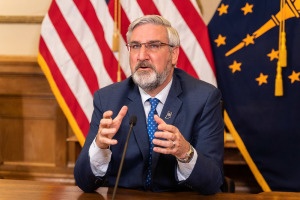Subscriber Benefit
As a subscriber you can listen to articles at work, in the car, or while you work out. Subscribe Now
Flush with unexpected state revenue and federal pandemic relief funds, Gov. Eric Holcomb and Republican legislative leaders revealed a revised state two-year budget Tuesday that invests a historic $1.9 billion in additional funding for K-12 education—more than double the previous proposed hike—and provides a healthy boost in economic grants and building projects.
The proposed budget, which state lawmakers will need to vote on before the session ends this week, also invests $500 million—more than three times the previous commitment—of federal stimulus dollars in grants to spur regional economic expansion initiatives. The original amount proposed for this fund was $150 million.
Republican leaders proposed the revised $37.4 billion two-year state budget, with higher spending levels in some areas, in light of a rosy revenue forecast they announced last week. A new state tax revenue forecast projects collections will increase more than 4% in each of the next two years. That could mean about $2 billion more available for the new budget. The last forecast projected growth between 2% and 3%.
With Republicans holding supermajorities in both the House and Senate, their budget plan is expected to pass easily.
The GOP leaders were enthusiastic over the prospects of being able to use the additional state funds, plus $3 billion in federal stimulus funds designed to aid recovery from the COVID-19 pandemic.
“I think we are living in a rare time and place and space, and we’re going to seize the day,” said Holcomb. “This budget is truly transformational.”
He said the plan is significant in its investments in people and in infrastructure projects and spending around the state.
“It’s going to help us accelerate away from 2020 at a faster pace, increasing that momentum as we continue to reinvest in Hoosiers themselves,” said Holcomb.

Senate President Pro Tem Rodric Bray, R-Martinsville, said he imagines many other states would like to find themselves in the same position as Indiana. He highlighted the increased investment in education, a $1 billion reduction in the overall state debt, including a $60 million contribution to the teacher pension fund, and infrastructure investments in high-speed internet and other needs.
“We’re making record investments in Hoosiers’ health and mental health,” he pointed out. “We’re also supporting law enforcement with salary increases.”
House Speaker Todd Huston, R-Fishers, said the revised budget reflects Hoosiers’ priorities, which means making strategic investments for the future but not focusing on increasing government spending.
The leaders said the budget lives within the state’s means, maintains healthy reserves in both years of the two-year budget cycle, and proposes “conservative spending levels” that will provide opportunities for future tax cuts and reforms. Maintaining more than $2 billion in reserves in each of the two years, they said, protects taxpayers, guards against future recessions and ensures Indiana maintains a triple-A credit rating.
Holcomb stressed the help small businesses will receive and the initiatives that will accelerate economic recovery. Under the plan, the state will invest $500 million—compared to $150 million proposed previously—in the Regional Economic Acceleration and Development Initiative (READI). It supports communities across the state and encourages them to become part of a regional effort to develop innovative policies for economic growth.

The budget also directs $60 million of stimulus dollars to the Hoosier Hospitality Small Business Restart Grant Program, aimed at helping small businesses get back on their feet. Another $75 million will go toward the Career Accelerator Fund to incentivize educational programs leading to high wage and high demand jobs. Other steps increase the cap on venture capital investment tax credits to $20 million per year, establish a bonus credit for investments in minority and women-owned businesses, and appropriates $10 million per year for manufacturing readiness grants and $500 million into the state unemployment insurance trust fund.
Infrastructure investments using the $3 billion in federal funds include:
· $250 million for broadband expansion
· $160 million for water infrastructure grants
· $550 million for a capital reserve account for state building projects
· $60 million for “Next Level Trails” around the state
· $25 million to support conservation land acquisition and preservation
· $900 million for Next Level Connections fund for future state infrastructure projects.
· Funding to upgrade National Guard armories and Indiana State Police posts
· $50 million for the Fall Creek Pavilion at the Indiana State Fairgrounds.
Huston explained that all of the $3 billion was appropriated, but only $1.6 billion was for specific projects in the next two-year budget cycle. The funds can be spent through 2024. “We will have a chance to come back and make strategic changes based on recommendations of legislature,” he said.
The $1.9 billion increase in spending for K-12 education boosted support for traditional public schools, school choice programs and vouchers for private schools.
“In Indiana’s budget, all Hoosier kids win,” said Indiana Secretary of Education Katie Jenner. The state’s transformational funding increase, she said, “puts our schools on solid footing to accelerate beyond the challenges of the last year.”
Jenner said Indiana educators, in particular, should benefit from the budget because lawmakers embraced several key recommendations of the Teacher Compensation Commission to increase teacher pay, strengthen the state’s teacher pipeline, and attract and retain the best teachers.
The budget increases K-12 tuition support funding by $1.03 billion or 9.1% over the biennium. Over the two years, that means K-12 education spending will total $16.37 billion.
Bray explained the revised budget supports three concepts developed by the commission. He said the state recommends a minimum $40,000 beginning teacher salary, and although it isn’t required, districts have to send a report to the Department of Education explaining why they can’t reach that amount. At least 45% of districts’ tuition support has to go into teachers’ salaries, and schools can’t drop the teachers’ total salary fund below the previous year’s level, he said.
The budget includes a few provisions backed by the House, including expanding the income eligibility for parents to receive school Choice Scholarships and increasing per student charter school grants. Bray said that the Senate agreed to such provisions because of the additional funds available to increase public school teachers.
The overall budget, Holcomb said, will be an asset to the state’s recovery from the pandemic and will aid individuals by investing in workforce development and opening up the pipeline for people who want to go to work right out of high school.
“You’re going to see first and foremost this is a truly balanced budget providing certainty for folks who want to make their home in Indiana,” he said.
“There are a lot of folks around the world anchored to the pandemic and the negative effects of what that has brought about,” he added. “Indiana is different. We are now prepared to build the kind of state we want to be in 2030 or 2040, so every corner of our state can realize their dreams.”
Please enable JavaScript to view this content.

I have no issues with Indiana saving and being conservative but the money the state is getting from the government should be spent to do everything they plan and more if Indiana is to keep up with surrounding states.I would love to see investment into a major attraction in Indy and make white river a tourist attraction.Theres no need in holding on to all the money, they should spend it to make Indiana a more desirable place to live and to attract out of state talent as well as keep homegrown talent. Indiana definitely has a perception problem that needs to be addressed.
Ditto
Agree, 100%.
“Big Things” like a White River State Park or other tourist attraction have been abandoned because it seems to come down to the right set of people being able to control the money generated and then there’s the problem of Race in this city that makes coming together “problematic”.
Your comment is problematic, Charles. It sounds like you might be the problem here.
I applaud the conservative money management of the Indiana government. Spending every penny now is a recipe for debt and disaster, kind of like driving a car until the gas tank is empty instead of leaving enough in the tank to make to another gas station. How the money is spent is always debatable.